


xxxxxThe English painter and engraver William Hogarth was the first British painter of repute. He was a particularly fine portrait artist - be his subjects wealthy friends or humble servants - but he is best remembered today for his pictorial narratives, satirising the corruption, vices and follies of everyday life in the London of his day. Made into engravings, these genre scenes, such as The Rake's Progress (1735), Marriage à la Mode and The Election, drove home a moral point - not without humour - and proved hugely popular. He was a close friend of the artist Sir James Thornhill, under whom he studied, the actor David Garrick, and the writer Henry Fielding, for whom he produced the frontispiece for his epic drama Tom Thumb. In 1753 he published his Analysis of Beauty, setting out his artistic principles. Other works included the pictorial satires The Harlot's Progress and Gin Lane, set in the seamier side of city life. Notable among his portraits are one of his friend, Miss Mary Edwards, and a delightful study of The Shrimp Girl, a work which has gained international acclaim for its vivacity and charm, achieved with but few colours and a remarkable freedom of brushwork.
WILLIAM HOGARTH 1697 - 1764 (W3, AN, G1, G2, G3a)
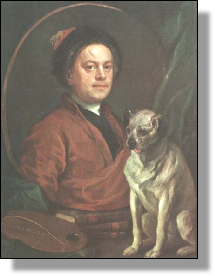 xxxxxThe painter and engraver William Hogarth was the first British painter of repute and, arguably, the finest of Britain's pictorial satirists and moralists. He produced, in fact, a large number of fine character portraits, but he is best remembered today for his genre scenes, all illustrating in stark reality the London of his day. In these he pulled no punches, satirising the corruption, vices and follies of contemporary life as no artist had done before and only few have done since. Little escaped his keen observation, and many of his paintings (or series of paintings) were produced with some moral lesson in mind, together with a generous helping of dry, caustic humour. Made into engravings, such picture narratives as The Rake's Progress (1735), Marriage à la Mode, The Election, and Gin Lane became hugely popular and were sold widely by subscription. (In the self-portrait, his dog Trump is doubtless included to emphases the pugnacity of his master!)
xxxxxThe painter and engraver William Hogarth was the first British painter of repute and, arguably, the finest of Britain's pictorial satirists and moralists. He produced, in fact, a large number of fine character portraits, but he is best remembered today for his genre scenes, all illustrating in stark reality the London of his day. In these he pulled no punches, satirising the corruption, vices and follies of contemporary life as no artist had done before and only few have done since. Little escaped his keen observation, and many of his paintings (or series of paintings) were produced with some moral lesson in mind, together with a generous helping of dry, caustic humour. Made into engravings, such picture narratives as The Rake's Progress (1735), Marriage à la Mode, The Election, and Gin Lane became hugely popular and were sold widely by subscription. (In the self-portrait, his dog Trump is doubtless included to emphases the pugnacity of his master!)
xxxxxHe was born in London and, save for a short visit to France, lived his entire life there. Following the failure of his father's business, the whole family was imprisoned for debt over a period of some five years, and this gave the young Hogarth, then in his teens, a depressing insight into the seamier side of city life, a section of society that he came to depict so successfully in later years. At the age of 16 he began work as an apprentice to a silver plate engraver, but in 1720 he cut short his training and set up his own business. Recognition came six years later when he produced engravings for the poem Hudibras, the work of the English poet Samuel Butler. Then further success came in 1728 when he completed a number of oil paintings - six in all - depicting scenes from the Beggar's Opera, John Gay's masterpiece.
xxxxxIt was soon after this that he began painting his famous social scenes of London life. Produced as paintings and then made into engravings, these provided what he himself called "a punctual paymaster". His first series of 1732, A Harlot's Progress, traced in six episodes the downfall of a country girl on arrival in London, and this was soon followed by A Rake's Progress, the story of a young man who spends his time in riotous living, and ends up in a lunatic asylum. Both drove home the lessons to be learnt, as did his graphic masterpiece Gin Lane, an engraving of 1751 specifically intended to "reform some reigning vices peculiar to the lower Class of People". But it is perhaps in his six paintings entitled Marriage à la Mode, produced as engravings in 1745 and taking to task the hypocrisy surrounding the marriage of convenience, that his close regard to detail and the savagery of his satire are seen at their best. And deserving of special mention, too, is his The Election, a series of four exuberant works which chronicles in boisterous style the corruption and violence that were endemic in the politics of that time.
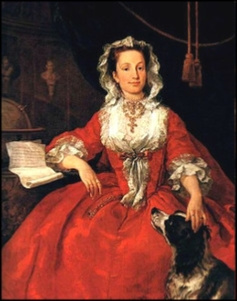
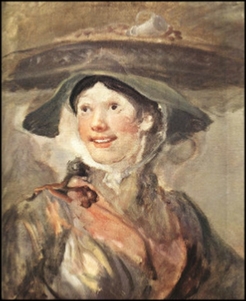 xxxxxApart from his acute observations on contemporary life, he also attempted historical and biblical themes on a grand scale, such as the highly ornamental murals produced for St. Bartholomew's Hospital, the March of the Guards towards Scotland (1746), and his Sigismonda Mourning over the Heart of Guiscardo, now in the Tate Gallery, London. Whilst he was not totally at ease in this type of work, he excelled in portraiture, a field in which he has not been accorded, perhaps, the credit he deserves. He was particularly accomplished at portraying children - to be seen in The Graham Children (illustrated below) - and produced some very grand portraits, including that of his friends Benjamin Hoadly, Bishop of Winchester and Miss Mary Edwards (illustrated left). But perhaps the most outstanding work in this genre is his The Shrimp Girl (illustrated right), painted around 1740. This delightful study is noted for its very limited range of colour - mostly in shades of green and red - and the remarkable freedom of Hogarth's brushwork. The result is a fleeting glimpse, as it were, of this lively, captivating young lady. A painting which has earned international acclaim, it can now be seen in the National Gallery, London.
xxxxxApart from his acute observations on contemporary life, he also attempted historical and biblical themes on a grand scale, such as the highly ornamental murals produced for St. Bartholomew's Hospital, the March of the Guards towards Scotland (1746), and his Sigismonda Mourning over the Heart of Guiscardo, now in the Tate Gallery, London. Whilst he was not totally at ease in this type of work, he excelled in portraiture, a field in which he has not been accorded, perhaps, the credit he deserves. He was particularly accomplished at portraying children - to be seen in The Graham Children (illustrated below) - and produced some very grand portraits, including that of his friends Benjamin Hoadly, Bishop of Winchester and Miss Mary Edwards (illustrated left). But perhaps the most outstanding work in this genre is his The Shrimp Girl (illustrated right), painted around 1740. This delightful study is noted for its very limited range of colour - mostly in shades of green and red - and the remarkable freedom of Hogarth's brushwork. The result is a fleeting glimpse, as it were, of this lively, captivating young lady. A painting which has earned international acclaim, it can now be seen in the National Gallery, London.
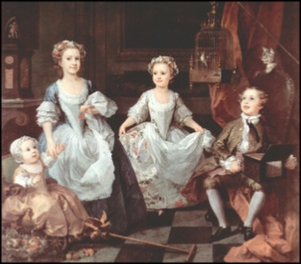 xxxxxHogarth was a great admirer of the history painter Sir James Thornhill, the first English-born painter to receive a knighthood. He attended his academy in Covent Garden during the 1720s, and in 1735 opened his own school for young students in St. Martin's Lane. He was anxious to encourage British art, for ever arguing that the nation's artistic talent was constantly ignored because of a mindless devotion to the "old masters" and all things French or Italian. He was also a close friend of the English writer Henry Fielding and provided the frontispiece for his heroic drama Tom Thumb. Likewise Fielding's play The Covent Garden Tragedy of 1732 was partly inspired by A Harlot's Progress.
xxxxxHogarth was a great admirer of the history painter Sir James Thornhill, the first English-born painter to receive a knighthood. He attended his academy in Covent Garden during the 1720s, and in 1735 opened his own school for young students in St. Martin's Lane. He was anxious to encourage British art, for ever arguing that the nation's artistic talent was constantly ignored because of a mindless devotion to the "old masters" and all things French or Italian. He was also a close friend of the English writer Henry Fielding and provided the frontispiece for his heroic drama Tom Thumb. Likewise Fielding's play The Covent Garden Tragedy of 1732 was partly inspired by A Harlot's Progress.
xxxxxIn 1751 he retired to his house in Hogarth Lane, Chiswick (now a museum), and two years later produced his Analysis of Beauty, a treatise setting out his artistic principles based on lines of beauty and grace. In 1757 he was appointed sergeant painter to George II, but his last years were somewhat marred by an acrimonious dispute with the English political reformer John Wilkes. He died at his home in Chiswick, and his monument bears a moving epitaph by his close friend, the actor David Garrick. Talented artist though he was, his immediate influence was limited. As the English painter John Constable later observed, "Hogarth has no school, nor has he ever been imitated with tolerable success". Today, however, he is seen as the most accomplished English painter before Reynolds and Gainsborough, and without equal in his combined skills as a painter and engraver.
xxxxxIncidentally, alarmed at the widespread pirating of his prints by unscrupulous printers and publishers, Hogarth campaigned long and loud for an Engravers' Copyright Act (sometimes called the Hogarth Act) and was gratified to see it passed through Parliament in 1735.
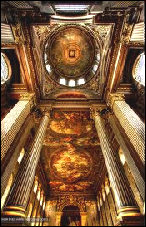
xxxxxThe English artist Sir James Thornhill (1676-1734), whose London drawing school was attended by Hogarth, gained fame on the strength of his large-scale ceiling and mural decorations. He was responsible for the eight scenes in the dome of St. Paul’s Cathedral, and his work - very much influenced by his study of Italian Baroque - included decorative interiors at Greenwich Hospital, Hampton Court, and Blenheim Palace. His painting on the ceiling of the Royal Naval College at Greenwich, Triumph of Peace and Liberty, took 20 years to complete and measures 106 x 51ft, the largest painting in Great Britain (part illustrated).
xxxxxAmong his portraits were those of Isaac Newton and Richard Steele. He served three monarchs, Queen Anne, and the first two Georges, and he was knighted in 1720. He was a Member of Parliament from 1722 to 1734. Hogarth married his daughter, Jane, in 1729, and the following year the two artists produced a group portrait of the members of the House of Commons.
xxxxxIncidentally, thexlargest painting in the world was produced in 1846 by the American painter John Banvard (1815-1891). Called The Panorama of the Mississippi, it was 12ft high and, being more than half a mile long, was wound around two gigantic rollers, one at each end. He put his panorama on display in Boston and New York, and such was the interest shown that he then toured abroad, visiting London, Manchester, Bath and Liverpool. Unfortunately this vast picture was never photographed, and it did not survive its creator. Part was destroyed by fire, and the remainder was cut up to provide theatre backdrops. As a work of art it was far from the greatest in the world, but it was certainly the biggest.

xxxxxOne of Hogarth's outstanding portraits was that of his friend, the philanthropist Captain Thomas Coram (1668-1751). Distressed by the plight of so many homeless children in London, he established the country's first foundling hospital. Many artists, including Hogarth, displayed their work there (anticipating the Royal Academy), and donated pictures in aid of the charity, and the German composer George Frederick Handel contributed the receipts from an organ recital and a performance of his Messiah.
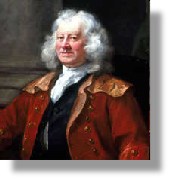 xxxxxOne of Hogarth's outstanding portraits (here illustrated) was that of his friend, the philanthropist Captain Thomas Coram (1668-1751). He was born at Lyme Regis in Devon, England, and, joining the merchant navy, made a fortune from trading with America and supplying stores to the Royal Navy. During visits to London he was deeply distressed by the sight of so many homeless children. In 1739 he established a foundling hospital in Bloomsbury, the first of its kind, for the care and education of abandoned children.
xxxxxOne of Hogarth's outstanding portraits (here illustrated) was that of his friend, the philanthropist Captain Thomas Coram (1668-1751). He was born at Lyme Regis in Devon, England, and, joining the merchant navy, made a fortune from trading with America and supplying stores to the Royal Navy. During visits to London he was deeply distressed by the sight of so many homeless children. In 1739 he established a foundling hospital in Bloomsbury, the first of its kind, for the care and education of abandoned children.
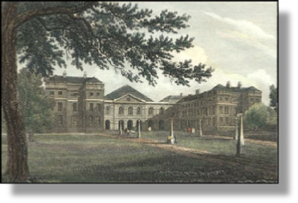 xxxxxHogarth became one of the governors of this hospital and sold some of his pictures in aid of the charity. In addition, when the building was completed in 1745 (illustrated), he persuaded a number of fellow artists to display some of their works there so as to encourage the public to visit the "exhibition" and contribute towards the running costs of the hospital. This was the first public showing of contemporary art in Britain, and paved the way for the foundation of the Royal Academy in 1768. Among other notables who assisted the work of the charity was the German-born composer George Frederick Handel. He contributed the receipts from an organ recital and a performance of the Messiah.
xxxxxHogarth became one of the governors of this hospital and sold some of his pictures in aid of the charity. In addition, when the building was completed in 1745 (illustrated), he persuaded a number of fellow artists to display some of their works there so as to encourage the public to visit the "exhibition" and contribute towards the running costs of the hospital. This was the first public showing of contemporary art in Britain, and paved the way for the foundation of the Royal Academy in 1768. Among other notables who assisted the work of the charity was the German-born composer George Frederick Handel. He contributed the receipts from an organ recital and a performance of the Messiah.
xxxxxIncidentally, the 18th century saw a large increase in the number of hospitals in Britain. Eleven were established in London, 37 in the provinces, and nine in Scotland.
Acknowledgements
Hogarth: Self-Portrait, The Painter and his Pug – Tate Gallery, London; The Harlot – lost in a fire; Chairing the Member – Sir John Soane’s Museum, London; The Rake – Sir John Soane’s Museum, London; Miss Mary Edwards – Frick Collection, New York; The Shrimp Girl – National Gallery, London; The Graham Children – Tate Gallery, London; Portrait of Thomas Coram (detail) – Foundling Hospital, London. Hospital: tinted pencil and ink drawing by the English artist John Preston Neale (1780-1847), contained in his The Foundling Hospital, The Beauties of England and Wales, published 1816. Ramsay: The Artist’s Wife – National Gallery Scotland, Edinburgh; Jean Abercromby – York Art Gallery, England; Countess of Cavan – National Gallery of Victoria, Melbourne; Countess of Stafford – Bourne Fine Art Gallery, Edinburgh; Miss Cragie – The Berger Collection, Denver Art Museum; Lady Banff – National Trust for Scotland, Leith Hall, Huntley, Aberdeenshire.
G2-1727-1760-G2-1727-1760-G2-1727-1760-G2-1727-1760-G2-1727-1760-G2-1727-1760-G2
xxxxxAnother successful portrait painter at this time was the Scotsman Allan Ramsay (1713-84). He anticipated the grandiose style of his great rival to-be Joshua Reynolds, having been influenced by classicism during his visits to Italy. However, many of his portraits were also noted for their rococo light touch, and this doubtless accounts for his particular success in capturing the charm and tenderness of women - to be seen in his masterpiece The Artist's Wife of 1755. He was appointed painter to the king in 1767, but by then, as a member of Samuel Johnson's literary circle, he spent much time in intellectual pursuits. One of his most famous portraits was that of the French philosopher Jean Jacques Rousseau.
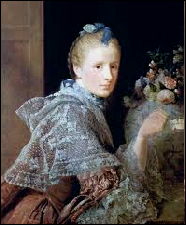 xxxxxAnother talented portrait artist at this time was the Scottish painter Allan Ramsay (1713-1784). Having studied art in Edinburgh, London and Italy, he settled in London in 1739 and, by the elegance and charm of his work, was soon in demand by royalty and high society. Such was his success, particularly after his second visit to Italy in the mid 1750s, that in 1767 he was appointed artist to the king. His style somewhat anticipated Joshua Reynolds' "grand manner", but unlike his rival - who succeeded him as the royal painter in 1784 - many of his portraits were noted for their rococo lightness and refinement rather than for their classical grandeur. As a result, he was particularly successful in capturing the charm and tenderness of women, as can be seen in his masterpiece The Artist's Wife, produced in 1755 (here illustrated), and in the portraits below. He had two studios, one in London and one in Edinburgh, and in the latter part of his career much of his work was put into the hands of his assistants.
xxxxxAnother talented portrait artist at this time was the Scottish painter Allan Ramsay (1713-1784). Having studied art in Edinburgh, London and Italy, he settled in London in 1739 and, by the elegance and charm of his work, was soon in demand by royalty and high society. Such was his success, particularly after his second visit to Italy in the mid 1750s, that in 1767 he was appointed artist to the king. His style somewhat anticipated Joshua Reynolds' "grand manner", but unlike his rival - who succeeded him as the royal painter in 1784 - many of his portraits were noted for their rococo lightness and refinement rather than for their classical grandeur. As a result, he was particularly successful in capturing the charm and tenderness of women, as can be seen in his masterpiece The Artist's Wife, produced in 1755 (here illustrated), and in the portraits below. He had two studios, one in London and one in Edinburgh, and in the latter part of his career much of his work was put into the hands of his assistants.
xxxxxShown here, (left to right) are: Jean Abercromby (Mrs Morison of Haddo), the Countess of Cavan, the Countess of Stafford, Miss Craigie and Lady Banff.

xxxxxApart from painting, Ramsay was a member of Samuel Johnson's literary circle and, as such, played a prominent part in the intellectual life of London, especially from the 1760s onwards. Amongst those with whom he corresponded were Voltaire and Jean Jacques Rousseau - whose portrait he painted in 1766. In 1778 he damaged his arm and was obliged to stop painting.
Including:
James Thornhill,
Thomas Coram
and Allan Ramsay







 xxxxxThe painter and engraver William Hogarth was the first British painter of repute and, arguably, the finest of Britain's pictorial satirists and moralists. He produced, in fact, a large number of fine character portraits, but he is best remembered today for his genre scenes, all illustrating in stark reality the London of his day. In these he pulled no punches, satirising the corruption, vices and follies of contemporary life as no artist had done before and only few have done since. Little escaped his keen observation, and many of his paintings (or series of paintings) were produced with some moral lesson in mind, together with a generous helping of dry, caustic humour. Made into engravings, such picture narratives as The Rake's Progress (1735), Marriage à la Mode, The Election, and Gin Lane became hugely popular and were sold widely by subscription. (In the self-
xxxxxThe painter and engraver William Hogarth was the first British painter of repute and, arguably, the finest of Britain's pictorial satirists and moralists. He produced, in fact, a large number of fine character portraits, but he is best remembered today for his genre scenes, all illustrating in stark reality the London of his day. In these he pulled no punches, satirising the corruption, vices and follies of contemporary life as no artist had done before and only few have done since. Little escaped his keen observation, and many of his paintings (or series of paintings) were produced with some moral lesson in mind, together with a generous helping of dry, caustic humour. Made into engravings, such picture narratives as The Rake's Progress (1735), Marriage à la Mode, The Election, and Gin Lane became hugely popular and were sold widely by subscription. (In the self-
 xxxxxApart from his acute observations on contemporary life, he also attempted historical and biblical themes on a grand scale, such as the highly ornamental murals produced for St. Bartholomew's Hospital, the March of the Guards towards Scotland (1746), and his Sigismonda Mourning over the Heart of Guiscardo, now in the Tate Gallery, London. Whilst he was not totally at ease in this type of work, he excelled in portraiture, a field in which he has not been accorded, perhaps, the credit he deserves. He was particularly accomplished at portraying children -
xxxxxApart from his acute observations on contemporary life, he also attempted historical and biblical themes on a grand scale, such as the highly ornamental murals produced for St. Bartholomew's Hospital, the March of the Guards towards Scotland (1746), and his Sigismonda Mourning over the Heart of Guiscardo, now in the Tate Gallery, London. Whilst he was not totally at ease in this type of work, he excelled in portraiture, a field in which he has not been accorded, perhaps, the credit he deserves. He was particularly accomplished at portraying children - xxxxxHogarth was a great admirer of the history painter Sir James Thornhill, the first English-
xxxxxHogarth was a great admirer of the history painter Sir James Thornhill, the first English-

 xxxxxOne of Hogarth's outstanding portraits (here illustrated) was that of his friend, the philanthropist Captain Thomas Coram (1668-
xxxxxOne of Hogarth's outstanding portraits (here illustrated) was that of his friend, the philanthropist Captain Thomas Coram (1668- xxxxxHogarth became one of the governors of this hospital and sold some of his pictures in aid of the charity. In addition, when the building was completed in 1745 (illustrated), he persuaded a number of fellow artists to display some of their works there so as to encourage the public to visit the "exhibition" and contribute towards the running costs of the hospital. This was the first public showing of contemporary art in Britain, and paved the way for the foundation of the Royal Academy in 1768. Among other notables who assisted the work of the charity was the German-
xxxxxHogarth became one of the governors of this hospital and sold some of his pictures in aid of the charity. In addition, when the building was completed in 1745 (illustrated), he persuaded a number of fellow artists to display some of their works there so as to encourage the public to visit the "exhibition" and contribute towards the running costs of the hospital. This was the first public showing of contemporary art in Britain, and paved the way for the foundation of the Royal Academy in 1768. Among other notables who assisted the work of the charity was the German- xxxxxAnother talented portrait artist at this time was the Scottish painter Allan Ramsay (1713-
xxxxxAnother talented portrait artist at this time was the Scottish painter Allan Ramsay (1713-



